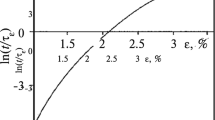Abstract
In this paper, we present, in a synthetic way, the practice of modeling textile materials and structures. To this end, we consider two aspects in this investigation: first, the numerical aspect of the modeling and then the experimental aspect as a tool for the identification of the constitutive equations invested in the modeling. It is a question, initially, of bringing a methodological approach for the modeling of the textile structures, in particular the woven structures, the formulation of laws of behavior making it possible to describe the response of these structures to mechanical solicitations. We present and discuss a review of the main models used. Secondly, we introduce a methodological approach for the experimental identification of the parameters of these constitutive laws.
Access this chapter
Tax calculation will be finalised at checkout
Purchases are for personal use only
Similar content being viewed by others
References
Long J., Burns K. et Yang J., Cloth Modeling and Simulation: A Literature Survey, chez Digital Human Modeling—Third International Conference, ICDHM 2011, Held as Part of HCI International 2011, Orlando, FL, USA July 9–14, 2011, 2011.
Shuvo I., Fibre attributes and mapping the cultivar influence of different industrial cellulosic crops (cotton, hemp, flax, and canola) on textile properties, Bioresources and Bioprocessing, (17),1-28, 2020.
Ng N. H. et Grimsdale R. L.. Computer graphics techniques for modeling cloth. IEEE computer graphics and applications, vol. (16), 28–41, 1996.
Jevsnik S, Kalaoglu F, Terliksiz S, Purgaj J. Review of computer models for fabric simulation. Tekstilec, 57(4), 2014, 300–314.
Peirce F. T., The handle of cloth as a measurable quantity. Journal of the Textile Institute, (21), 377–416, 1930.
Olofsson B., A General Model of a Fabric as a Geometric-Mechanical Structure. Journal of the Textile Institute, (55), 541–557, 1964.
Weil J., The Synthesis of Cloth Objects. ACM SIGGRAPH Computer Graphics, (20), 49–54, 1986.
Agui T., Nagano Y. et Nakayama M., An expression method of cylindrical cloth objects an expression of folds of a sleeve using computer graphics. Transactions of the Society of Electronics, Information and Communications, vol. J73-D-II, 1095–1097, 1990.
Haumann D. R. et Parent R. E., The Behavioral Test-bed : Obtaining Complex Behavior from Simple Rules. The visual computer, vol. 4, 332–347, 1988.
Provot X., Deformation constraints in a mass-spring model to describe rigid cloth behavior. In Graphics Interface 95, 147–154, 1995.
Breen D. E., House D. H. et Philip H. G., A physically-based particle model of woven cloth. The visual Computer, (8), 264–277, 1992.
Fontana M., Rizzi C. et Cugini U., 3D virtual apparel design for industrial applications. Computer-Aided Design, (37), 609–622, 2005.
Terzopoulos D., Platt J., Barr A. et Fleischer K., Elastically deformable models ACM SIGGRAPH Computer Graphics, (21), 205–214, 1987.
Magnenat-Thalmann N. et Yang Y., New trends in animation and visualization, chapitre Techniques for cloth animation, 242–256. Wiley-Interscience, New York, 1991.
Hedfi H., Ghith A. et BelHadjSalah H., Dynamic fabric modelling and simulation using deformable models. Journal of the Textile Institute,102 (8), 647–667, 2011.
Ascough J., Bez H. et Bricis A., A Simple beam element, large displacement Model for the finite element simulation of cloth crape. Journal of the Textile Institute, (87), 152–165, 1996.
Boisse, P., Hamila, N., Badel, P., et Vidal-Salle, E., Simulations éléments- inis de la déformation de textiles aux échelles macro et mésoscopique. Mécanique & Industries, 10(1), 15–19, 2009.
Chen B. et Govindaraj M.. A physically based model of fabric drape using flexible shell theory. Textile Research Journal, (65), 324–330, 1995.
Yin H, Varava A, Kragic D. Modeling, learning, perception, and control methods for deformable object manipulation. Sci Robot, 6(54), 2021.
Liu, Z., Jagota, A., & Hui, C.-Y., Modeling of surface mechanical behaviors of soft elastic solids: theory and examples. Soft Matter, (16), 6875-6889, 2020.
Au, C. K., Wu, Z., & Yuen, M. M. F., Effect of fabric properties on cloth draping modeling. Proceedings Geometric Modeling and Processing 2000. Theory and Applications, 2000.
Author information
Authors and Affiliations
Corresponding author
Editor information
Editors and Affiliations
Rights and permissions
Copyright information
© 2024 The Author(s), under exclusive license to Springer Nature Singapore Pte Ltd.
About this paper
Cite this paper
Hedfi, H., BelHadjSalah, H. (2024). Modeling of Textile Materials and Structures: Some Numerical and Experimental Aspects. In: Abdessalem, S.B., Hamdaoui, M., Baffoun, A., Elamri, A. (eds) Proceedings of the Second International Conference of Innovative Textiles and Developed Materials-ITDM’2; 05-06 May 2023; Tunisia. ITDM 2023. Springer, Singapore. https://doi.org/10.1007/978-981-99-7950-9_30
Download citation
DOI: https://doi.org/10.1007/978-981-99-7950-9_30
Published:
Publisher Name: Springer, Singapore
Print ISBN: 978-981-99-7949-3
Online ISBN: 978-981-99-7950-9
eBook Packages: Chemistry and Materials ScienceChemistry and Material Science (R0)




